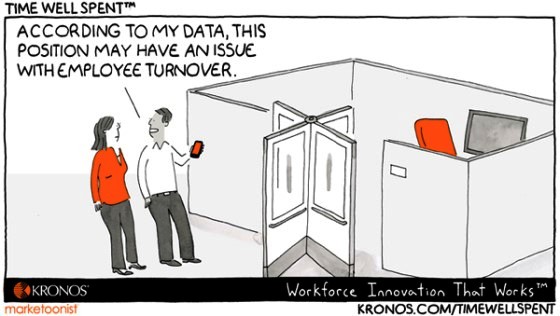Company Doors Drive Employee Turnover – Friday Distraction
Organizations have several different types of “doors”.
Some companies have configured their office space to have “no doors”. Everything is open. Employees work at communal tables. Meetings are held in little spaces that are pre-reserved. This open office concept has been seeing some backlash lately, but many companies swear by it as a way to encourage collaboration.
Then there are “open door” companies, which means that employees are encouraged to walk in, sit down, and say whatever is on their mind. Feedback is encouraged. Obviously, there’s a downside if the policy doesn’t match the practice.
Finally, some companies have the “revolving door”. Today’s Time Well Spent from our friends at Kronos explains it all too well.
The sad part about the cartoon is that often we don’t need data to see the revolving door of employee turnover. But we do need data to remove the revolving door. Think of data as the tools that will help take the door off its hinges and into the dumpster. When trying to impact employee turnover, there are three core data areas to examine.
- Recruiting and onboarding practices. Organizations need to look at their hiring practices to make sure they’re selecting the right people. And review the onboarding process to ensure new employees are being set up for success. If companies hire the wrong people and don’t properly train them, employees are sure to leave.
- Employee recognition and rewards. Employees want to know they’re doing a good job. And if they make an honest mistake – which does happen – that they will have an opportunity to fix it. If employees come into work every day not knowing what to expect, they will start looking for a more stable work environment.
- Retention and offboarding. Companies need to understand why employees leave. Correction: companies need to understand why employees start looking for another job. A subtle but important difference. More importantly, organizations should know the reasons employees stay with the company. It’s valuable information to share during the interview process (which leads us back to #1).
Next time you’re walking around your office, check out the doors. Which type(s) do you have? And are you okay with what you see?
0